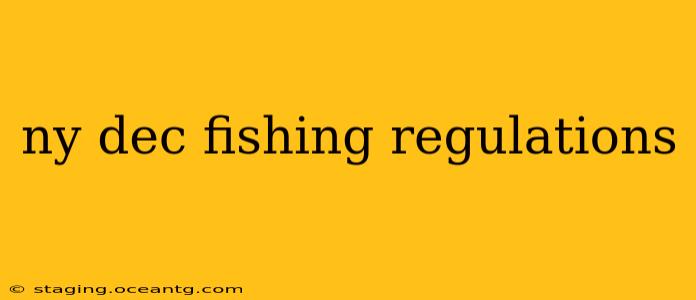New York boasts diverse fishing opportunities, from pristine Adirondack lakes to the sprawling waters of the Finger Lakes. However, navigating New York's Department of Environmental Conservation (DEC) fishing regulations can be tricky. This comprehensive guide will clarify the key rules and regulations to ensure you have a safe and legal fishing experience in the Empire State.
What is a New York Fishing License?
A New York fishing license is required for anyone aged 16 and older who fishes in the state's waters. This license allows you to legally fish for a wide variety of species, subject to specific regulations. You can purchase a license online, at participating license agents, or through the DEC's mobile app. Remember to always carry your license while fishing and present it to a conservation officer upon request.
What are the Different Types of New York Fishing Licenses?
The NY DEC offers various fishing license options to cater to different needs:
- Resident License: For New York State residents.
- Non-Resident License: For individuals who are not residents of New York State.
- Short-Term License: Available for shorter durations, ideal for visitors.
- Combination Licenses: These often bundle fishing and hunting licenses.
Choosing the right license type ensures compliance and allows you to enjoy the sport legally. Detailed information on license fees and purchasing options is available on the DEC website.
What Fish Species Can I Catch in New York?
New York's waters are home to a remarkable variety of fish species, including:
- Largemouth Bass: A popular game fish found in many lakes and ponds.
- Smallmouth Bass: Known for their aggressive strikes and fighting ability.
- Trout: Various trout species, including brook, brown, and rainbow trout, inhabit many streams and rivers.
- Walleye: A prized game fish sought after for its delicious flesh.
- Northern Pike: A powerful predator inhabiting many lakes and rivers.
- Muskie: The "fish of 10,000 casts," challenging anglers with their size and strength.
Specific size and creel limits apply to each species, so it's crucial to check the DEC regulations for your target fish and location.
What are the Size and Creel Limits for Different Fish?
Size and creel limits are critical aspects of New York's fishing regulations. These limits vary considerably depending on the species, the specific body of water, and the time of year. The DEC website provides detailed tables outlining these restrictions. It's crucial to familiarize yourself with these limits before you go fishing to avoid accidental violations.
What is the Open Season for Fishing in New York?
The open season for fishing in New York varies depending on the species and location. Generally, the open season for most species runs throughout the year, but specific restrictions apply to certain species during spawning seasons or to protect vulnerable populations. Always consult the official DEC regulations for the specific fish and location you plan to fish.
What Gear Restrictions Apply to Fishing in New York?
New York has certain gear restrictions, such as limits on the number of hooks, lines, and types of tackle allowed. These vary by species and location. For example, some areas may restrict the use of live bait, while others might have limits on the size of fishing lures. Reviewing the DEC regulations for your chosen location is crucial to ensure compliance.
Where Can I Find the Official New York DEC Fishing Regulations?
The most accurate and up-to-date information on New York's fishing regulations is available on the official New York State Department of Environmental Conservation (DEC) website. This website provides comprehensive details, including maps, species-specific regulations, and licensing information.
By adhering to these regulations, you contribute to the conservation of New York's valuable fish populations and ensure the sustainability of fishing for future generations. Remember, responsible angling is key to preserving this cherished natural resource.
